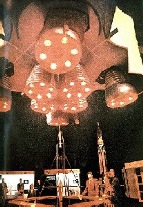|
The Seattle World Exposition 1962 and the New York World Exposition 1964
The Science Exhibition
|
Year: | 1962 | | City: | Seattle | | Country: | USA | | Duration: | 21th April - 21th October 1962 |
|
1
2
| 
Copyright: National Geographic. September 1962 |
|
The exposition of Sciences
In the boxlike buildings of the U.S. Science pavilion, three of the most illustrious designers of the time, Charles Eames, Raymond Loewy and Walter Dorwin Teague, had the opportunity to use the most modern exhibition design to justify American research promotion. Eames produced a 15 minute film as introduction that was shown on seven screens on a long curved wall – called ‘The House of Science’ – unfolding the basics and horizons of science. Critics at the time praised the beauty of the images – close-ups of opening blossoms and boiling lava streams interlaced with pictures of observing and experimenting scientists in laboratories – as well as the technical perfection of the projection with restrained comments and “suitable electronic music”.
To look back on the history of science since the ancient world, important experiment set-ups were shown as models; as a contrast they were rooms demonstrating present-day laboratory work. 28 research groups tried to answer questions of mankind like “What circumference does the world have?” or “How does salmon find back to their spawning grounds?”. Especially favoured were behavioural animal experiments with doves that learned easily and were rewarded with feed for their test results. The great systems of physics and biology like the period table of elements by Mendelejev and the DNA-spiral discovered by Watson and Crick were suspended from the ceiling as three-dimensional models. Additionally, rooms had been set up where visitors were invited to rediscover natural phenomenon, for instance rooms to test the human perception with experiments.
The rocket and space travel show was substantially financed and equipped by the NASA because NASA wanted to justify the immense amount of money spent on the moon landing programme passed by President Kennedy. As a spectacular highlight of the show, the start of a Saturn-rocket was simulated with a light and sound system. Aircraft constructer Boeing tempted visitors with an intergalactic trip in the “Spacearium” to star systems two million light years distant to the spiral nebula Andromeda. The illusion of travelling – projected on a huge screen with the biggest film projecting lens - was so perfect that visitors had to grab the banisters to hold on to.
There was always a big crowd to see the science pavilion, every 20 minutes a new group of people was guided through the show. All together 6.748 million people were counted in the pavilion. The day after the closing of the exposition the government leased the buildings for a symbolic price of one dollar per year and set up the Pacific Science Center that has been working ever since to pass on the achievements of science to the wider population.
Space travel was also the theme of the Amusement Park “Gayway” for a few weeks – a rather dubious amusement though. On the ‘Planet Eva’ a few topless showgirls from deep space cast their spell on astronauts in glittering plastic spacesuits. Already in May the show was closed down for “professional and not moral reasons” as a spokesman for the world exposition indicated.
|



